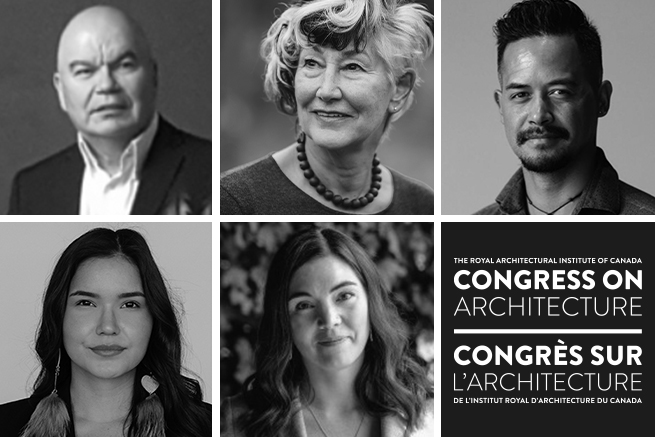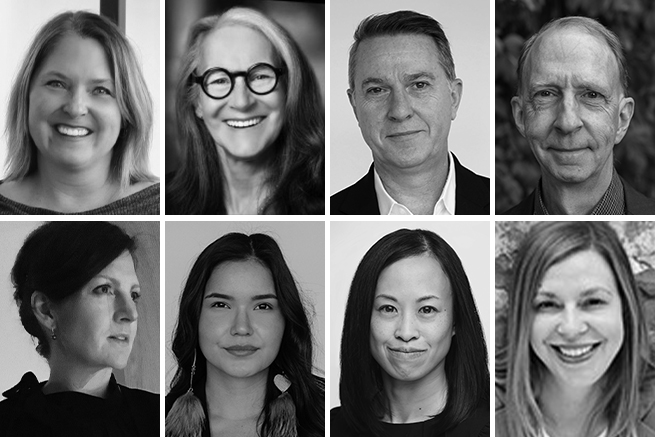REGISTER Now
Part 1: Indigenous Sharing Circle

Simoogit Saa Bax Patrick R. Stewart – PhD, Architect AIBC, NCARB, FRAIC
Patrick Stewart is a member of the Killerwhale House of Daaxan of the Nisga’a Nation. He has operated his firm, Patrick R. Stewart Architect, for 26 years. Patrick was the first architect of First Nations ancestry in B.C. to own and operate an architectural firm in B.C. (1995) and the first person of First Nations ancestry elected as President of the Architectural Institute of British Columbia (2005-2007). He has chaired the Royal Architectural Institute of Canada (RAIC) Indigenous Task Force since 2015 and has co-chaired the RAIC Truth and Reconciliation Task Force since 2019. Patrick has also chaired the Provincial Aboriginal Homelessness Committee in B.C. since 2005.
He is an alumnus of Simon Fraser University (BA), Dalhousie University (BEDS, BArch), McGill University (MArch) and University of British Columbia (PhD). Patrick is also an Adjunct Professor at the McEwen School of Architecture at Laurentian University, Sudbury, Ont. He has had the privilege to be a co-editor of Our Voices: Indigeneity and Architecture (2018) and Our Voices II: the decolonial project (2021), both published by ORO Editions. Currently, he is the lead editor for the forthcoming book, Our Voices III: catalysts for change (2022) to also be published by ORO Editions.
It is important to Patrick to always give back to community, whether it is within his Nation, the architectural profession or those less fortunate. Having been born homeless and growing up in care, Patrick has never taken anything for granted. He continues to push the boundaries and look to the future.
Harriet Burdett-Moulton – NWTAA, FRAIC, Ph. D. (hc) / Senior Architect (Dartmouth, NS)
Métis architect Harriet Burdett-Moulton, Fellow of the Royal Architectural Institute of Canada (RAIC), was the first architect to practice in what is now known as Nunavut. One of the most iconic and important projects to Harriet as a Métis person is the Piqqusilrvvik Inuit Learning Facility in Clyde River, Nunavut. Piqqusilrvvik—which roughly translates as “a place to keep the things we’ve learned”—is a cultural learning facility specifically designed for the Inuit culture.
Harriet is from Labrador, with Inuit, British and Montagnais roots. She spent her early life in a traditional nomadic lifestyle. In 1976 Harriet graduated from TUNS, now Dalhousie School of Architecture, and became the first Indigenous female Architect in Canada in 1979. She is a member of the RAIC Indigenous task force and is well-respected and honored architect. In May 2016, Harriet was made a fellow of the RAIC, in June 2017, she received an Honorary Doctorate of Design from Ontario College of Art and Design (OCAD) University in Toronto, and in November 2017, she was awarded a Labradorian of Distinction metal.
Harriet has been responsible for numerous design projects across northern Canada building her expertise in collaborating with culturally diverse groups designing an assortment of building types. She has been involved in the design of educational facilities, recreational facilities, health care facilities, places of worship and feasibility studies. Her work encompasses major additions, and renovations as well as new construction. In addition to her passion for well-designed culturally significant buildings, she is an award-winning jeweler and has experience and education in community international development.
Whare Timu
Whare Timu tōku ingoa (My name is Whare Timu)
He mokopuna nā Te Huhuti, nāna i kau i tāna tau ā Te Whatuiāpiti (I am a grandchild of Te Huhuti, she who swam to her love, Te Whatuiāpiti)
Arā, Nō Kahungunu te iwi ahau (Therefore, I am a descendent of the tribe Kahungunu)
Whare is a Principal and senior design lead and cultural advisor with over 15 years’ experience across a range of sectors in the built environment. He leads Warren and Mahoney’s Advanced Indigenous Design Unit – Te Matakīrea, dedicated to empowering indigenous architecture in Aotearoa New Zealand, Australia and the Pacific.
Whare has a deep understanding of tikanga Māori (custom and protocol) and is practiced in whaikōrero (oratory) and kapa haka (performance). His experience comes from a diverse range of projects and developments, including papakāinga (intergenerational housing), large scale typology housing, culturally-driven public architecture, and infrastructure. His capability in highlighting cultural impact with our partners and clients enables him to undertake specific roles as cultural advisor and stakeholder design manager, creating mutual outcomes and objectives for the benefit of all our partnerships.
Whare is passionate about sustainable design as an extension of Te Ao Māori and is a strong advocate for low impact and natural materials.
Reanna Merasty
Reanna Merasty is an architectural intern at Number Ten Architectural Group based on Treaty 1 Territory. She is a Nîhithaw (Woodlands Cree) artist, writer, and educator from Barren Lands First Nation. Reanna received a Master of Architecture and a Bachelor of Environmental Design from the University of Manitoba (UofM).
Reanna advocates for Indigenous inclusion and representation in design education and is committed to empowering Indigenous communities and youth. While at the UofM, she Co-founded the Indigenous Design and Planning Student Association and Co-Edited the publication “Voices of the Land: Indigenous Design and Planning from the Prairies.” Additionally, Reanna is working with Portage & Main Press on a three-part children’s book series on Indigenous Architecture.
Her work continues to amplify Indigenous voices, community engagement, and land-based pedagogies in architecture locally and nationally. She is a member of the Indigenous Task Force with the RAIC, Manitoba Regional Director with the RAIC Board of Directors, Chair of the Welcoming Winnipeg Committee with the City of Winnipeg, and a member of the local design advocacy organization Storefront Manitoba. Through this advocacy work, Reanna was recognized by CBC Manitoba with a Future 40 Award, by Women in Urbanism Canada as one of the 14 Mobilizing Women Impacting Urbanism in Canada and named the 2023 Youth-First Nations Laureate with the Indspire Awards, which is considered the highest honor Indigenous people bestow upon its own people.
Alanna Quock – Intern Architect, AIBC, MRAIC, MILFI
Principal, Regenative Design. Alanna is a Tāłtān and Tlingit planner, designer, and creative problem solver with a passion for building adaptive capacity. Alanna grew up in Whitehorse, Yukon, the home of the Ta’an Kwachan Council and Kwanlin Dun First Nations, and now calls the territory of the shishalh Nation home. Alanna has 20 years experience working with individuals, first nations, communities and governments in the Yukon, BC and Quebec. Alanna is most comfortable when navigating a space of ambiguity and complexity – she seeks to use design thinking as a practical and creative approach to bring clarity and simplicity to complex situations. Her training in architecture supports her ability for cross-scale interdisciplinary thinking that allows her to quickly see patterns and bring together disparate elements into a cohesive whole. As project lead Alanna knows how to build and coordinate a team to get the job done. Alanna’s approach to community-based project design and delivery has been recognized as leading the way in global indigenous design practice.
Alanna is also a member of the RAIC Indigenous Task Force and Low Carbon Education Advisory Committee.
Part 2: Where are we now: Canadian Architectural Community Perspectives

Mona Lemoine – Architect AIBC | MRAIC | LEED AP BD+C, LFA | Regenerative Practitioner | RELi AP
Associate, Senior Sustainability Consultant at Dialog. Mona is a licensed architect with more than twenty-three years of experience in the built environment. Her work addresses the urgencies of climate change by offering design solutions that weave together resilience, equity, health, and biodiversity considerations. As part of these efforts, Mona remains focused on designing and building projects that are enabled to draw down carbon emissions—rather than contribute to them—through material performance, circular economy, and regenerative design and development. In combining big-picture systems thinking with attention to detail, Mona works together with clients to craft a carbon impact vision, fit with both ambitious and achievable goals that support their ideal outcomes for the project.
Mona is the Chair of the Royal Architectural Institute of Canada (RAIC) Committee on Regenerative Environments (CORE), and Co-Chair of the RAIC Climate Action Engagement and Enablement Plan (CAEEP) steering committee. Prior to joining DIALOG, she was Executive Director of the Cascadia Green Building Council, responsible for the successful leadership and operation of the International Living Future Institute’s bioregional program. Simultaneously, she was Vice-President, Education and Events, responsible for overseeing, planning, curating, and producing the organization’s internal-external education and events including their annual, international signature event, the Living Future unConference. Her influence has created a ripple effect throughout DIALOG’s culture and practice, design approach and delivery, as well as performance on projects locally, regionally, and internationally.
Joanne Perdue – Architect AAA, MRAIC, LEED Fellow
Joanne is the Associate Vice President, Sustainability at the University of Calgary. She is an architect, a Canada Clean50 Honouree, and the recipient of the Canada Green Building Council’s Lifetime Achievement Award (2022). Joanne founded the University of Calgary’s Office of Sustainability in 2007. Since then, the University has attained multiple recognitions as one of Canada’s top universities in sustainability, including a Times Higher Education top five percent global ranking for progress in advancing the United Nations Sustainable Development Goals for the past four years. Joanne plays a leadership role in advancing the University of Calgary’s Climate Action Plan and commitment to carbon neutrality by 2050. To date, the university has achieved a 39% reduction in greenhouse gas emissions representing approximately 90,000 tonnes of annual emissions. Joanne has a research focus on the intersection of architecture, climate change, and resilience. She is an avid supporter of preparing future leaders and of empowering women to accelerate the transformation toward a sustainable future.
Joanne is also co-chair of the RAIC Climate Action Engagement and Enablement Plan Steering Committee, and a member of the Committee on Regenerative Environments and the Low Carbon Education Advisory Committee.
John Peterson – OAA, FRAIC
John is a highly accomplished architect with over 30 years of experience in all design and construction phases. Believing that an architect should provide intelligent design solutions that make sense in a world where climate change is the preeminent problem, he has developed a reputation for successfully designing and managing challenging projects with award-winning sustainable designs throughout his professional career. He is well-known across Canada for his advocacy and thought leadership in low-carbon and regenerative design.
His desire to create performative designs has developed into a nationally recognized expertise in façade design and development. His experience working on tall, complex and refined projects gave him a unique playground to hone this skill. John has always advocated for the use of technology within architecture and design. John spearheaded the early industry adoption of BIM and continues to push for leveraging digital analysis to inform the design process through its successful implementation on signature design projects. John is regularly asked to speak at façade expert-oriented events or panel discussions. To give back to the profession, John volunteers time and leadership to several committees within the RAIC and the Commonwealth Association of Architects. John sees this as essential to his professional activity by maintaining a vibrant and connected profession.



